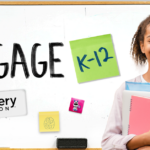By Veronica Torres
Originally published in the March/April 2020 issue of AC&E
Education is a common and important thread that binds us all. For some, the student experience provides exactly what is needed developmentally and shapes who the individual becomes as a functioning adult in society. For others, the years spent in school stifle and ultimately fail to prepare the student for real world experiences. In fact, many exit high school uninspired, unmotivated, and unchallenged. They have missed the opportunity to fine tune and polish their work, or even worse, accept feedback necessary to make revisions to the work they produce, all of which are foundational skills critical for success at the college level and beyond.
But why is that and what can be done to change it?
Many of these challenges that manifest in classrooms today result from the well-intended No Child Left Behind Act of 2002. Following implementation of NCLB, the focus en masse could no longer be on project-based learning, research, or application of skills or knowledge. It became the nearly impossible task of getting students to mastery of convoluted curriculum benchmarks or standards as measured by some form of “standardized” assessment. The standardized assessment became a threatening but national marker for a student’s academic success versus failure.
As a result, the classroom has become, for many, a source of tension and anxiety. Nowadays students are subjected to the completion of assessment after replicated assessment with every bit of energy, focus, and commitment they have in them. Teachers rarely have the time or opportunity to stop and fill in gaps as they know they should because the next assessment looms. Those who see this practice in action are likely haunted by an overwhelming feeling that this approach simply isn’t working. This “drill and kill” methodology, while seemingly student-centric as it provides much needed standardized assessment practice, is absolutely not that and is in fact a disservice in the long run.
If you were riding on a train that you knew would eventually fall off of a cliff, would you not jump off of it? Would you also not expect the other riders to follow suit? We already know that education is in a state of crisis.
Our current approach is not effective and every day serves as a detriment to teachers and students
It is critical to jump off of our misguided education train and enact changes that not only undo the ramifications from 2002 but push us forward, innovating our educational practices at the same time.
To do so would require policymakers and educators to acknowledge this, collaborate, and commit to making adjustments with teachers and students at the forefront of their decision-making process. The modern-day classroom experience must be reignited to incorporate personalized elements while maintaining a focus on standardized achievement data that is valuable when used appropriately. It is likely not going away any time soon. The goal would be to go back to the drawing board and initiate a total educational revolution, much like what Henry Ford did for the auto industry when he developed his innovative assembly line. We must move from what is, to what could potentially be within the realm of teaching and learning, the importance of which cannot be overestimated.
The good news is the strategies and tools to get there are already available whenever we decide we are ready for this meaningful endeavor. Teachers must be equipped with strategies for formative assessment and tools to implement it in a way that is manageable and realistic. Doing so would maximize student accountability, engagement and knowledge acquisition and once again allow the teacher to feel successful and effective in his or her role.
Simply put, formative assessment relies on snapshot data being generated or produced following a short snippet from within a longer lesson
The teacher instructs with an understanding that the attention span is limited, assesses, analyzes, and adjusts in the moment. Then the teacher repeats that cycle over and over throughout the lesson. By doing so, the train is constantly being steered back in the right direction as soon as it begins to veer off course. The students are not left behind, but included as the focus of the instruction, and hence are given the opportunity for success.
Perhaps the easiest way to understand this phenomenon is to think about the work done by athletics coaches or teachers of the arts.
- When athletes play sports the coach is able to observe how they play and provide immediate feedback. The player will likely try the play again or even complete practice drills to fine tune his or her performance.
- The art teacher observes the developing artist in action as they complete or perform a piece. The art teacher might notice that part of a still life drawing has been sketched incorrectly and asks for it to be erased and redone.
- A dance teacher notices a dancer repetitively practicing a step incorrectly and provides the necessary feedback for the dancer to fix it.
But how can teachers apply strategies like these in the classroom setting?
Arguably a majority of classroom-based activities are difficult to observe, especially when one considers there are on average 20 students all working simultaneously on potentially multi-step problems. To circumvent this limitation, teachers often incorporate activities that make the learning visible. Students are provided with large white boards to display the work they are completing and the teacher can see what’s being done from a distance. Or the teacher might truncate chunks of a lesson and assess students using quick and easy to answer questions at its conclusion. There are a variety of ways this can be done, but the challenge becomes having the ability to reference back to this information over the long term to analyze performance over time. When it comes time for the teacher’s next data meeting with their school leaders, what do they have to show for these innovative practices they are implementing on a daily basis?
Not much.
But for many educators out in the field, these typical daily conundrums have already become a thing of the past. These select teachers have been equipped with tools to formalize their practice for formative assessment. The immense pressure teachers and students feel in preparing for the big standardized test at the end of the year has been alleviated. Students are provided with clickers, not unlike video game controllers, during their lessons which they use to respond to questions posed by the teacher on the fly that the teacher deems important to gauge the students’ learning at that moment. Data appears on the teacher’s computer screen or classroom display. Teachers and students can immediately see what the class average was in response to the posed question. If they did well as a whole, the class moves on. If they struggled, the question is reviewed and corrected. If a few struggled, the majority might move on to another question or activity while the teacher pulls those few to the back of the room to immediately intervene. Data collected from the use of these clickers is imported into an electronic grade book with a few clicks saving teachers hours upon hours as they are no longer confronted with grading individual assignments and having to go back and then enter those grades into their gradebook. When it comes time for the big data meeting, a running record of data from previous days and weeks of instruction is stored in a cloud-based system and can immediately be pulled for analysis. Teams of teachers can reference this information together and make decisions about how to use it to best assist their students in coming weeks.
While there are a number of options to use technology tools for formative assessment, the products providing the functions outlined above come from a Texas-based company called ALL In Learning. Following a district-wide adoption of the ALL In products, Dallas Intermediate School District reported record gains over a five year period, reducing their list of schools on the “Improvement Required” list of D and F schools from 43 in 2013 to 3 in 2018. Dallas became the fastest improving district in the state, with Dallas ISD being the only district to put up double-digit numbers in reference to their academic gains.
Imagine results like these on a grand scale- with ongoing use of formative assessment strategies and the clicker as the vehicle that makes them “go.” The lesson becomes fluid, adapting to the needs of the students as they learn material in the classroom. The teacher, likely more at ease than those who lack these important tools, feels confident that they are investing in the success of their students over time. With this, could the rigors of the teaching profession ultimately be tempered? Could we not immediately impact the student experience and engage learners at a level we have never experienced before in this country?
We absolutely could. And we absolutely need to.
Prestige Mentors Owner and CEO Veronica Torres began working in education in 2004. She has worked alongside the best in the world acquiring experience in a variety of areas. She has instructed in a variety of settings from private tutoring to teaching multiple grade levels and subjects in public schools and in the charter sector. She has led grant-funded education programs, conducted research in education for the Combined Program in Education and Psychology at the University of Michigan. As a former Content Developer with Marzano Center of West Palm Beach and Curriculum Specialist and Assistant Principal with Charter Schools USA, she has produced and delivered professional development at a number of conferences and in training and webinar formats for a national and worldwide audience. Veronica is a published author providing insight into how best to apply strategy to maximize learning. Contact Veronica for ALL In information: www.prestigementors.com.
The American Consortium for Equity in Education, publisher of the "Equity & Access" journal, celebrates and connects the educators, associations, community partners and industry leaders who are working to solve problems and create a more equitable environment for historically underserved pre K-12 students throughout the United States.
- American Consortium for Equity in Educationhttps://ace-ed.org/author/admin/
- American Consortium for Equity in Educationhttps://ace-ed.org/author/admin/April 23, 2025
- American Consortium for Equity in Educationhttps://ace-ed.org/author/admin/
- American Consortium for Equity in Educationhttps://ace-ed.org/author/admin/







